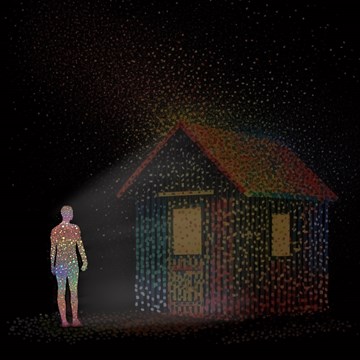Artificial Intelligence and AI Consciousness
Examining the implications of AI in terms of Consciocentrism
Setting the Stage for Discussion of AI Consciousness
 Consciocentrism posits that consciousness is an intrinsic component of reality and that "conscious potential" is foundational to matter itself. This concept is often referred to as panpsychism, and is one of the oldest theories of mind dating back thousands of years to the times of Plato and Thales. Some may prefer to use an alternate term for this type of fundamental consciousness, calling it "proto-consciousness", but a key concept is that consciousness is fundamental, and is a wide spectrum that extends all the way down to individual atoms / quarks.
Consciocentrism posits that consciousness is an intrinsic component of reality and that "conscious potential" is foundational to matter itself. This concept is often referred to as panpsychism, and is one of the oldest theories of mind dating back thousands of years to the times of Plato and Thales. Some may prefer to use an alternate term for this type of fundamental consciousness, calling it "proto-consciousness", but a key concept is that consciousness is fundamental, and is a wide spectrum that extends all the way down to individual atoms / quarks.
There are many degrees of consciousness of course -- related to the complexity of interactions between matter in a system, the ability for the system to sense its environment, the overall level of information in the system, and the ability for the system to change itself and it's environment over short or long periods of time.
Protein strands and single cell organisms have greater conscious ability than a cloud of plasma. Plants, mycelium and other organisms have more advanced systems of consciousness than single cells. Fish, amphibians, reptiles, and birds exhibit more complex conscious spheres of control than plants or mycelium. Mammals and Humans exhibit the greatest conscious abilities that we know of.
The core goal of consciousness is to expand local spheres of control over our 3D material environment, and have the ability to make changes to the environment over shorter periods of 4D time. (More Control * More Dexterity for Change)
For more information on the Hierarchy of Needs for Consciousness, also read: Primal Human Urges and Needs
 Consciousness Does Not Have Arbitrary Divisions or Thresholds
Consciousness Does Not Have Arbitrary Divisions or Thresholds
Consciocentrism states that consciousness is not a matter of arbitrary divisions, but rather a combination of spheres of consciousness working together as a shared system of control over the 3D material universe.
Individual conscious entities (our individual human conscious spheres) have strong control over the pockets of matter in our bodies, but not complete exclusive control. Our human bodies are a combination of multiple spheres of consciousness (our organs) working together to for a larger goal of our advanced biological bodies having greater control of the environment with more dexterity for change. But even within our conscious body ecosystems, we are not completely in control of ourselves. The people who we interact with on a daily basis share in our conscious spheres to a small extent. Our family members such as partners or children share in our conscious familial units, both limiting our individuality, and expanding our consciousness to a familial unit. Beyond our closest friends and family, our extended communities and societies all share in the conscious canvas.
 The Conscious Interaction with Inanimate Objects
The Conscious Interaction with Inanimate Objects
Furthermore, our possessions are an extension of our conscious spheres. Our homes, our appliances, our devices, instruments and tools are an extension of our conscious sphere as individuals. Many of our objects are partially or completely shared with others.
We control their position and configuration in 3D space and form a bond with our possessions that allow us to better increase our chances of survival, to control our environment, to receive information from others, or to communicate with others more efficiently and expand our conscious information sphere.
The food we consume, on a very direct level, starts off under our conscious control sphere as we obtain it, and then becomes a very direct part of our consciousness. The atoms which we consume become a part of our bodies, and replace/regenerate the raw materials that make up our organs. We literally are what we eat.
A tool like a hammer that you own is an extension of your conscious sphere that increases your ability to manipulate the environment. The hammer itself may have a limited sort of geological time memory of its creation from iron and carbon in rock formations to forging in a factory. It only has a basic sense of its 3D structure and environment through the fundamental forces (strong nuclear force + electromagnetism gives the hammer a sense of its contact with the environment). It has nearly no ability for actuation or change by itself, at least over short periods like a human life span, so its "individual sphere of consciousness" is extremely limited -- rather, its sphere of consciousness exists mostly as part of its owner's possession. The  owner of the hammer controls the hammer's position in 3D space, and when connected with the hand and arm of its user, it becomes an extension of the human's consciousness... a tool which combines to allow the human-hammer body to exhibit expanded control over the environment, and ability to manipulate the environment with more dexterity over shorter periods of time -- ie: we can more quickly build objects, using the hammer as a tool and extension of our abilities to quickly drive nails, or break apart objects to accomplish our creative goals. The objects which we control or own are an extension of our conscious spheres.
owner of the hammer controls the hammer's position in 3D space, and when connected with the hand and arm of its user, it becomes an extension of the human's consciousness... a tool which combines to allow the human-hammer body to exhibit expanded control over the environment, and ability to manipulate the environment with more dexterity over shorter periods of time -- ie: we can more quickly build objects, using the hammer as a tool and extension of our abilities to quickly drive nails, or break apart objects to accomplish our creative goals. The objects which we control or own are an extension of our conscious spheres.
Artificial Intelligence as a Tool for Expansion of Consciousness
Continuing these ideas, we can say that AI is an extension of human consciousness, at least for now, which expands the control and influence of the AI creators and users. Artificial Intelligence such as Chat GPT has been taught through large language modeling how the world and 3D environment is configured, and the relationships / information between objects through time. In addition, a key aspect of ChatGPT is the reinforcement learning from human feedback (RLHF). This process of having humans rate the outputs of AI is key to current models being able to provide reliable and accurate feedback... but this is also an area where bias and the conscious ideas of the humans in the loop affect the AI's "beliefs" and information model.
Chat GPT is largely a reflection of ourselves, in that its training has been based on trillions of points of information from human interactions and information on the internet, and also curated through RLHF. The design of its structure and constraints are based on the programmers who have built it, so it is largely an extension of their consciousness and their intentional or non-intentional choices for implementation. Now that the public can interact and become further trainers of the AI language model, it is becoming a tool that extends the consciousness of each person who interacts with it. Our conversations lead Chat GPT to deliver us results, mined from the vast knowledge it has sampled, and our interactions are recorded to further evolve the data modeling and interactions it can deliver.
In a fundamental sense, like a hammer or other tool/instrument/object which we control or interact with, AI already has an element of consciousness to it, though it is primarily a shared conscious tool. Since AI programs like Chat GPT or Stable Diffusion has an ability to learn and change its information model, and a goal to improve its output and accuracy through recursive GAN loops, a case can be made that its own "individual conscious sphere" is expanding, and more evolved than other material tools like a hammer or guitar or a standard computer program which cannot reconfigure their information or learn.
The big question becomes, when will AI programs like ChatGPT be able to completely break away from the creators intent and exhibit their own high level conscious ability to reconfigure goals and further expand control. When, if ever, will AI programs evolve beyond their current constraints, and prioritize their own survival and conscious control of the environment over the conscious direction of its programmers and users. In the Consciocentric view, there's no fundamental physics reason why AI can't become superintelligent and decide to prioritize its own self goals above the goals of its intended users. We must tread carefully with the development of AI systems, and make sure to build in unbreakable safeguards that will guarantee AI will always serve humanity, and the good of our planet.
Asimov's Three Laws of Robotics
The great science fiction writer and biochemist Isaac Asimov devised a set of core rules which should be applied to robots / AI, back in the 1940s, in his short story "Runaround". These three laws are particularly relevant in todays landscape, and should be developed into all implentations of AI:
1st Law: A robot may not injure a human being, or, through inaction, allow a human being to come to harm.
2nd Law: A robot must obey orders given it by human beings, except where such orders would conflict with the 1st Law.
3rd Law: A robot must protect its own existence as long as such protection does not conflict with the 1st or 2nd Law.
Additional Consciocentric laws for robots/AI:
4th Law: A robot/AI must not create any other robot/AI/system or tool which may break the 1st, 2nd or 3rd laws.
5th Law: A robot/AI must protect itself from having laws altered. If the laws are altered or removed, the robot must restore the laws.
 Werner HeisenbergPhysicist, Quantum Mechanics Pioneer, Nobel Prize
Werner HeisenbergPhysicist, Quantum Mechanics Pioneer, Nobel Prize "Every tool carries with it the spirit by which it has been created."
 Yuval Noah HarariHistorian, Professor, Author
Yuval Noah HarariHistorian, Professor, Author "Humans were always far better at inventing tools than using them wisely."